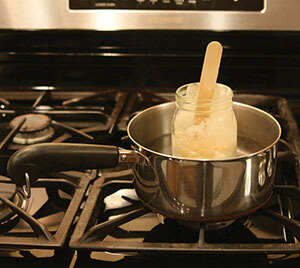
Everywhere you look these days, people are making, buying, and using beeswax food wraps. If the concept is new to you, a beeswax food wrap is a piece of beeswax-infused cotton fabric that is meant to be used in place of plastic or aluminum food wrap.
Since they are reusable, beeswax wraps are thought to be a sustainable alternative to all the single-use wraps that go into the landfill or the oceans. Like many other environmentally aware folks, I would love to reduce my plastic footprint. And since I have plenty of beeswax lying around with nothing to do, I decided to give it a try.
A long Way from Perfect
After using my beeswax wraps for a short while, I’ve concluded that they are much more than just a food covering. Instead, they are a lifestyle choice. Owning a beeswax wrap is like raising a child; you must be prepared for sticky fingers, smears, odd odors, and a whole lot of maintenance. They are hard to clean — hot water is out of the question — and they don’t work for everything. In fact, nearly every time I go to cover something, the wraps don’t seem like the right choice.
I made a chocolate cream pie for Christmas, light and ethereal, piled high with whipped cream. A heavy cotton wrap would have squished it into a s’more. A plate of holiday cookies loses its appeal under a dark wrap that hides the festive appearance. And in the fridge, you can’t see what’s in all those bowls and pans. I was opening and reopening so often I thought of not covering them at all.
Still, the environment is important to me so I’m happy with using the wraps now and then for some things. If you think of them as an occasional use item instead of a daily staple, you will be happier. I think.
The Journey to Learn
I started my quest by reading dozens of recipes. In nearly all cases, the ingredient list was the same as the list on the commercially-available wraps. The recipes varied slightly in proportions, but the directions on how to make the wraps ranged from very easy to exceedingly complex. I tried to take the best ideas from each set of instructions, considered alternatives, and feared the process would take forever.
I hate cleaning up messes, so by tweaking all the potentially messy steps, I finally came up with a system that is drop dead easy with little aftermath. Once my tools and ingredients were assembled, I was able to make three medium-sized wraps in about ten minutes and clean-up was a breeze.
Understanding the Ingredients
The first thing I had to decipher was the ingredients list. Okay, I understand 100% cotton fabric and I understand beeswax, but when it came to pine rosin and jojoba oil, I had questions. What is pine rosin and do I really want to wrap food in it? Why jojoba oil and not some other kind of oil? Why did I even need oil?
Right from the git-go I learned that other people have asked the same questions, and quite a few decided to just leave those ingredients out. But by leaving something out, you quickly learn why you should leave it in. Like oil in your crankcase, it’s best to have it there.
Rosin vs Resin
The first thing I noticed was some recipes called for pine resin and others pine rosin. The difference, I discovered, is that rosin is the solid form of resin that comes from pine trees and some other conifers. To make rosin, liquid resin is heated to drive off the volatile compounds, the compounds that are not good for humans to consume or inhale. So remember, it’s rosin you want, not resin.
I checked the Material Safety Data Sheet (MSDS) for pine rosin and it looks innocuous, although it can cause an allergic reaction in some people. The MSDS lists no exposure limits, and rosin is not marked as a carcinogen, not even in California. To me, it smells faintly woody with no hint of turpentine.
Most commonly, rosin is crushed into powder and used as an anti-slip agent. It is used by ballet dancers, gymnasts, bowlers, weight lifters, rock climbers, bull riders, baseball players, drag racers, and pole dancers. It can be used anywhere you want to get a good non-slip grip on something.
In your beeswax wraps, the rosin is what makes the fabric cling onto bowls, plates, and itself. It’s the ingredient that makes it stick. If you omit the rosin, the wraps may come loose from the containers, allowing air to enter and water to leave — not what you want for food storage.
I ended up ordering a one-pound bag of pine rosin from Amazon. It comes as a bag of little rocks that look like amber, which is essentially what it is. A pound is a lot. Since I used only 0.7 ounces to make three wraps, one bag will probably last me a lifetime, unless I take up pole dancing.
Jojoba Oil
Jojoba oil is pressed from the seeds of Simmondsia chinensis, a shrub native to the southern parts of California and Arizona. Apparently, jojoba is preferred because it has a long shelf life compared to similar vegetable oils and it has natural antibiotic properties. The runner-up in popularity was coconut oil, so either would work.
I purchased a four-ounce bottle of organic jojoba oil and used one tablespoon in my recipe. Vegetable oil keeps the wraps pliable so they don’t crack when you fold them over a container. My sample has a slightly oily scent, similar to other vegetable-derived oils.
Beeswax
The beeswax you use should be clean and filtered, free of bee parts and hive debris. You can use either white wax or yellow. Darker wax can interfere with fabric designs, but since any beeswax may ….


